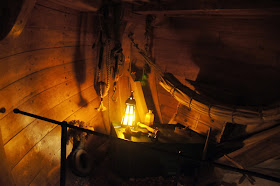 |
| The Pirates of Nassau Museum. |
 |
| The dock in Nassau. Ship is moored to the right with the shops to the left. |
 |
| The bow of the ship is where one of the most valuable man on the ship is located. He is the ship's carpenter and is responsible for the constant repairs. |
 |
| This display was titled "Marooned" and the following was posted with it. |
 |
| Click on it to enlarge it. |
Well, what ever happened to all the pirates. By 1720 pirate attacks along the shores of North America had become so frequent that colonial governors and merchants persuaded the Admiralty to send out warships to track down the pirates. They were captured and their crews put on trial. Some were hanged as stated above. With most of the ringleaders dead or in hiding, the great age of piracy came to an end. But what about in today's society? It was another extraordinary day in the life of an ordinary guy.















































